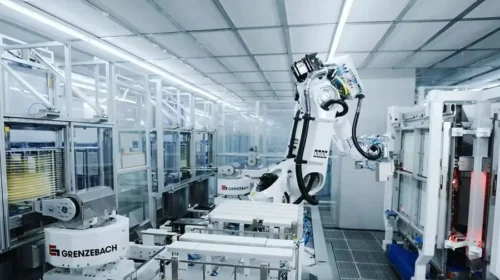Ganfeng Lithium Revs Up Battery Ambitions with LiEnergy Spinoff

The major producer of a key metal used to power new energy cars will pump 2 billion yuan into its young battery unit ahead of a planned spinoff
Key Takeaways:
- Ganfeng Lithium will spin off its LiEnergy battery unit, seeking to take advantage of higher valuations for battery makers compared with lithium producers
- The spinoff is probably a prelude to a separate listing for LiEnergy, which could come as soon as late 2023 when the unit is set to launch two major new production facilities
By Doug Young
Watch out world, here comes another major lithium battery maker.
In a trend that looks all too “made in China,” Ganfeng Lithium Group Co. Ltd. (1772.HK; 002462.SZ), one of the world’s top producers of the key metal used in electric car batteries, has announced it is throwing its hat into a lithium battery ring increasingly crowded with ambitious Chinese companies. More precisely, Ganfeng has announced a plan to spin off its young lithium battery unit, Ganfeng LiEnergy Technology Co. Ltd., into a separate company, according to a Hong Kong stock exchange announcement filed late on Wednesday.
We’ll look shortly at the details of the spinoff, as well as the broader landscape for electric vehicle battery makers, whose ranks in China have exploded these last few years.
But first we’ll examine the rationale for this particular move, which appears to be mostly a matter of valuation. Lithium producers like Ganfeng are seen mostly as commodity companies, and thus command relatively modest price-to-earnings (P/E) ratios, even as their profits have soared in the last two years on skyrocketing lithium prices with the rise of new energy cars.
Even after reporting a sevenfold rise in its third-quarter profit to 7.5 billion yuan ($1 billion) last month, Ganfeng’s Hong Kong-listed shares now trade at a P/E ratio of 7, while its Shenzhen-listed shares are slightly better at 10. The situation is similar for other major lithium producers, with rival Tianqi Lithium (9696.HK; 002466.SZ) trading at about 8 times, while Sociedad Química y Minera de Chile (SQM.US) trades at around 9 times.
By comparison, lithium battery makers trade at far higher ratios because they are seen as makers of value-added products rather than simple commodity companies. China’s own CATL (300750.SZ), the world’s leading battery maker, now trades at a P/E of 34, while the South Korean pair of LG Chem (051901.KS) and Samsung SDI (006400.KS) trade at multiples of 24 and 28, respectively.
That hints that this particular spinoff is almost certainly a prelude to a separate listing for Gangfeng LiEnergy, with Ganfeng Lithium hoping to get a significantly higher valuation for the unit as a standalone company than it would as part of a bigger mining company like Ganfeng Lithium.
The only hitch to that plan could be the timing element, since LiEnergy is currently building two major new manufacturing facilities that won’t start production until late next year. With so much new battery capacity flooding into the market and signs that the electric vehicle car market may be slowing, it’s quite possible a major correction could be in store for all members of the industry’s food chain. Such a correction could take a major bite out of LiEnergy’s valuation if it fails to list before the bubble bursts.
All that said, we’ll return our sights to the present by looking at Ganfeng’s spinoff plan, which includes a major capital increase to fund LiEnergy’s rapid expansion. Ganfeng said it will supply 2 billion yuan to LiEnergy, and will bring in another 11 external investors to supply up to another 390 million yuan. LiEnergy’s own employee stock ownership platform will supply another 213 million yuan.
Muted reaction
Ganfeng Lithium said that following the new capital contributions, LiEnergy’s registered capital would rise to 3 billion yuan from the current 2.13 billion yuan. It added it was making the spinoff “in accordance with the company’s development strategy of building Ganfeng’s ecological recycle chain, in order to promote the business development of Ganfeng LiEnergy, and (to) support its attempt to expand and strengthen its lithium battery business.”
Investors weren’t too excited about the plan, with Ganfeng’s Hong Kong-listed shares up just 1% on Thursday after the deal’s announcement, while its Shenzhen-listed shares were unchanged. That’s not too surprising since Ganfeng’s plans to build LiEnergy into a major new battery maker have been known for a while, and the spinoff is just the latest development in that roadmap.
LiEnergy’s website says it produces more than 20 types of lithium batteries in the five categories of solid-state batteries, consumer batteries, small polymer batteries, power batteries, and energy storage systems.
In August last year, Ganfeng announced a massive expansion for LiEnergy in two phases. The larger involved a 5.4 billion yuan investment in the interior megacity of Chongqing for a production center with annual capacity for 10 gigawatt hours (GWh) of batteries, as well as an advanced battery research institute. The other involved a 3 billion yuan investment in the company’s home province of Jiangxi for a facility with another 5 GWh of battery capacity.
Both facilities were set to start production towards the end of 2023. That means we’re unlikely to see a separate listing for LiEnergy before that time, though it’s still possible Ganfeng might try to rush things to take advantage of positive sentiment towards the sector.
Market sentiment is a key element in any listing plans, since such sentiment could change very quickly. Right now the sector is being boosted by booming new energy vehicle demand, which has helped to send lithium prices skyrocketing more than tenfold over the last two years. But more than half of global new energy vehicle demand is coming from China, where government incentives that could soon be retired are a major factor lifting the market.
The many signs of a building bubble haven’t deterred new battery makers from flooding into the sector and existing ones from sharply boosting their capacity. In addition to Ganfeng, China is also home to major battery makers CATL, BYD (1211.HK; 002594.SZ) and CALB (3931.HK), which listed in Hong Kong earlier this year. And also earlier this year we reported on Svolt, a state-backed player taking shape with plans for a whopping 600 GWh of capacity by 2025.
We suspect that a big chunk of all this new capacity being discussed will never actually be completed, or at least will be delayed until after the current bubble inevitably bursts. Still, LiEnergy’s relatively modest plans, combined with its stable lithium supplies from its parent, should make the company a relatively safe bet compared with some of its more aggressive rivals.
To subscribe to Bamboo Works weekly free newsletter, click here






